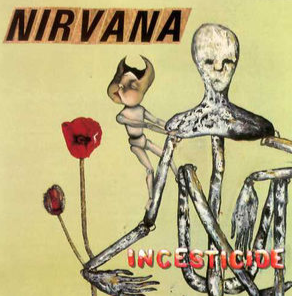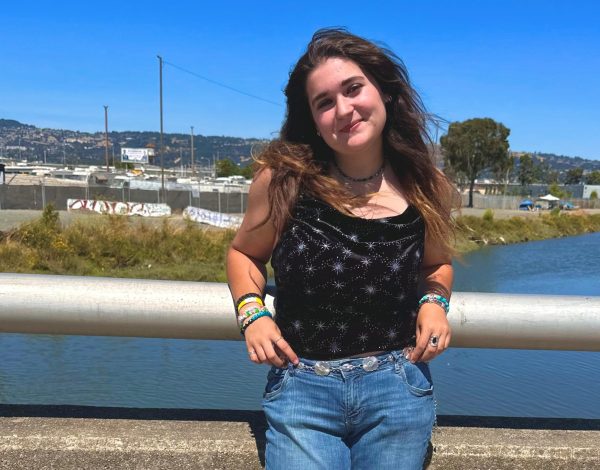30 Years of “Incesticide”
Delving into the history, writing, and instrumentation of Nirvana’s compilation album.

Nirvana’s “Incesticide” album cover that features the artwork from the lead vocalist and guitarist Kurt Cobain, credited in the liner notes of the record as Kurdt Kobain.
December 19, 2022
Alternative rock’s biggest and most predominant grunge band, Nirvana, released a compilation album that features a catalog of B-sides, covers, and alternate versions of some of their previously released tracks.
Just a year following their major label debut with “Nevermind” (1991), Nirvana released “Incesticide” on Dec. 14, 1992 ― marking the drop as the third album under the household name. The tracks within the album were recorded in sporadic sessions with various drummers: Chad Channing (the original drummer), Dan Peters, Dale Crover, and Dave Grohl (who remained with the band until the final days of Nirvana’s career).
During the time of the release of the album, the band’s lineup consisted of the late singer and guitarist Kurt Cobain, bassist Krist Novoselic, and drummer Dave Grohl.
The inconsistent time frame of recording tracks and numerous musicians featured on the album add to the theme that the album presented itself with; the record alone is inconsistent, making it all the more enjoyable and dynamic to listen to.
The compilation album opens with “Dive” ― the inheritance of the early tones of Nirvana from their debut album “Bleach” (1989). Originally composed in 1989, “Dive” became the B-side to their single “Sliver,” also a track re-released on “Incesticide” two years later. The 10th track on “Incesticide,” “Downer,” stands as the shortest track with rap-style lyricism and a catchy chorus. “Downer” first appeared as the final track on “Bleach.”
“Stain” and “Been A Son” were previously released on the “Blew” EP in 1989, which also featured the title track “Blew” and “Love Buzz” – a hard rock version of the Shocking Blues original.
“Incesticide” marks the band’s label transition from Sub Pop to DGC regarding the releases of full-length albums. All of the tracks on the record were written by Cobain in addition to Novoselic on a few songs, however, this excludes the three back-to-back covers positioned in the middle of the album.
From tracks five to seven, the band ventures away from their original tracks and includes three cover songs: “Molly’s Lips” and “Son of a Gun” from the Scottish alternative rock band the Vaselines, and “Turnaround” (originally titled “Turn Around”) by American rock band Devo. The cover songs of the album are also included on the EP “Harmoaning” (1992) which was only released in Australia and Japan.
Experimenting with different styles and compositions, Nirvana re-released one of their hits “Polly” but as more abrasive and fast-paced. First appearing on “Nevermind,” the original acoustic version brought awareness to a true malevolent incident told through the perspective of the assailant. Once added to the “Incesticide” line-up, the band created an alternate title, “(New Wave) Polly,” with rapid and syncopated drumming, an in-your-face guitar riff, and an established bassline with its prominent solo. “(New Wave) Polly” is credited to be written by Cobain, Novoselic, and Grohl.
Keeping the raucous sound, the album 180s with lyrics in the ninth track “Beeswax.” The colorful vernacular from Cobain is the main focus of the track along with dynamic instrumentation; specifically with the riff and periodic feedback.
With the now-established tone of loud and aggressive volumes, “Mexican Seafood” sustains the aggression through Cobain’s cacophonous vocal tone. The outlandish and extremely graphic details in the track further provide the stomach-churning tones that have been slowly revealed in the record. Yet you have to hand it to Cobain, he did have such a way with writing: spoon-feeding imagery to a listener – whether sought out for or unsolicited – he paints a clear picture of what’s written and described.
“Hairspray Queen” opens with the best bassline on the album, a sliding rhythm that remains prevalent throughout the refrain and then gives away for the sustained notes beneath the verses. Cobain provides an ominous tone in the refrains and harsh and ear-splitting screams mixed with the accusatory lyrics, creating a well-developed contrast within the track.
As a previously unreleased track, “Aero Zeppelin” features some of the best drum work on the album courtesy of Crover. Cobain showed no remorse when writing lyrics that describe the consumer aspect of the music industry and how music is beginning to lose its spark and individuality. This is supported by the chorus of the track, “All the kids will eat it up, if it’s packaged properly/Steal a sound and imitate, keep a format equally/Not an ode, just the facts, where our world is nowadays/An idea is what we lack, it doesn’t matter anyways.” The track closes with amazing guitar playing from Cobain, ornate drum fills, and a complimentary bassline.
The most listener-accessible track right behind the cover songs, “Big Long Now” is a masterpiece of hard-hitting vocals and each singular note of the track, from all counterparts, works hand-in-hand. The slower and vastly more melodic track exploits so much emotion through merely Cobain’s vocals alone. With only the few opening notes of the slightly distorted guitar ringing out, immediately the song is recognizable. The captivating vocals of the verses and the advanced instruments make the hypnotic track easy to listen to for hours.
“Aneurysm” brings the album to its ultimate conclusion as an uptempo number with a lengthy instrumental intro and repetitive lyrics of the chorus and outro. This isn’t the first time this song has appeared, as it was the B-side for Nirvana’s mega-hit single, “Smells Like Teen Spirit,” released in 1991.
After listening to the album and knowing Nirvana’s other material, it’s easy to see that “Incesticide” was catered to show listeners and the music industry the eccentric yet authentic version and sound of the band – contrary to the release of radio-friendly and listener-accessible hits especially found on their previous blow-up album. The commercial success of “Nevermind” brought the east Washington-native band new found fame and recognition, bringing more attention to the band with the release of the ‘92 compilation album.
“Incesticide” creates an overwhelming slew of emotion and reactions. An album that is as dynamic as “Incesticide” encompasses many hidden-gems that respectively make a listener regurgitate from explicit lyrics, blast the evocative compositions on their stereo, and aggressively headbang to the rocking tracks ― all occurring within the span of 45 minutes.


